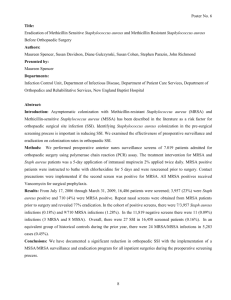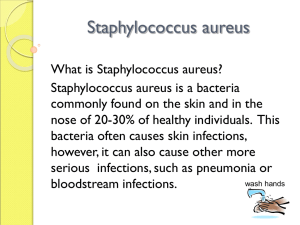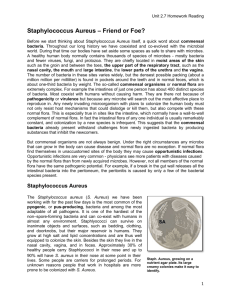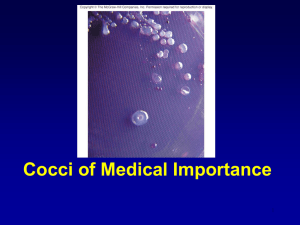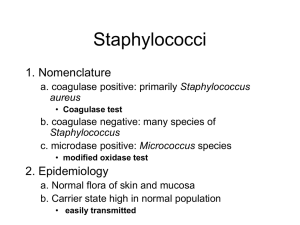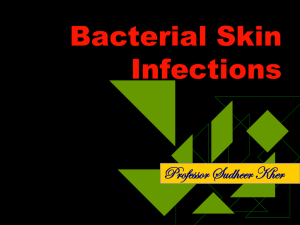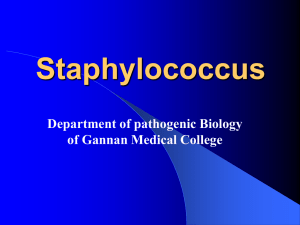S. aureus
advertisement
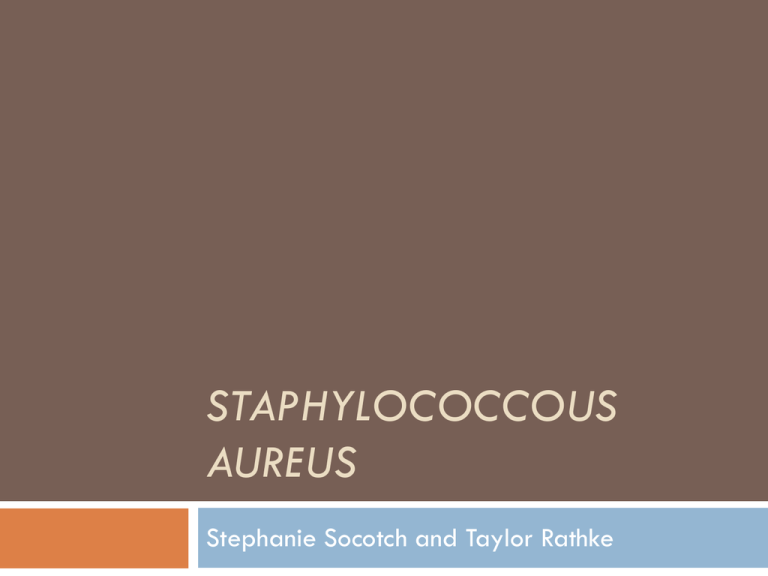
STAPHYLOCOCCOUS AUREUS Stephanie Socotch and Taylor Rathke History of Agent - Ancient Discovered by Scottish surgeon Sir Alexander Ogston in 1881. He observed grape-like clusters under microscope In 1884, Anton Rosenbach isolated two strains: Staphylococcus aureus and Staphylococcus albus By 1941 the disease was prevalent in hospitals and many patients had died from it. Later that year a British policeman was cured by penicillin. Doctors began using the antibiotic Benzyl penicillin to cure patients, but the Staphylococcus bacteria soon became resistant. History of Agent - Contemporary There are now several different effective antibiotics available to treat S. aureus infections. Most common antibiotics today: penicillin, ampicillin, and amoxicillin. How they work: They disrupt the bacterial cell wall, cause cell leakage, and cell death. Interesting Factoids Bacteria is carried on the human skin and in the nose 43% of all skin infections in the U.S. are the result of one strain of MRSA (methicillin-resistant Staphylococcus aureus) Most MRSA used to be hospital-acquired, but now, roughly 75% of MRSA is community-acquired (the patient is infected outside the hospital) An estimated 12 million patients are at risk for developing an S. aureus infection each year in the U.S. Example of Staphylococcus During a soccer game, Stephanie ended up sliding on the turf of the field she was playing on and acquired a large abrasion on her leg. She made sure to wash it with warm, soapy water and cover it with a bandage. Seven days later she woke up with and noticed her leg was extremely itchy. When she took a look she found that her leg was covered in red bumps all around the scratch site. She suspected it was Staph, so she decided to call the doctor when the bumps became puss-filled later that day. When she met with the doctor he diagnosed her with a Staphylococcus infection. He took a sample of one of the bumps and sent it to the lab to make sure he was correct. He prescribed her sulfamethoxazole, which is an antibiotic that treats for a variety of Staph and Strep infections. She took two a day for ten days and her infection cleared right up! She was so relieved that she didn’t infect anyone else while she had staff. Description of S. aureus bacteria Size: 0.5-1.5 microns Shape: Spherical Arrangement: Grape-like clusters Motility: Non-motile Staining Characteristics: Gram-Positive Culture Staining Characteristics: Facultative anaerobes that grow by aerobic respiration or by fermentation that produce lactic acid; usually form large yellow colonies on growth media Metabolic/Growth Characteristics: Optimum growth is 30-37 degrees Celsius. Virulence Factors and Functions They have surface proteins that promote colonization of host tissues. Invasins (protein produced by bacteria that helps them penetrate into mammalian cells) that promote bacterial spread in tissues. Examples are leukocidin, kinases, hyaluronidase) Surface factors that inhibit phagocytic engulfment such as capsules. Immunological disguises (Protein A, coagulase) Membrane-damaging toxins that lyse eukaryotic cell membranes (hemolysins, leukotoxin, leukocidin) Exotoxins that damage host tissues and create symptoms of disease Description of Staphylococcus It is spherical, Gram-positive, immobile and forms chains of grape-like clusters. Staphylococci are facultative anaerobes that use aerobic respiration, or fermentation producing lactic acid. Incubation time: The incubation period is variable; most commonly 4-10 days. Affects in Tissues/Organs S. aureus can get into the body and resist phagocytosis. If in the bloodstream, it can spread throughout the body and lead to circulatory collapse. This can affect people with lung diseases, which can lead to abscess formation in the lungs. The infection of heart valves can lead to heart failure. In the bones it can cause severe inflammation (oseomyelitis). Outward Symptoms Infected area will be tender, swell and will see signs of redness. Skin lesions will from like boils or styes. Skin infections can form a crusting of the skin. Mode of Transmission Transmitted by direct or indirect contact with a person infected, contaminated surfaces and medical equipment, or an open wound coming into contact with contaminated area. Diagnostic Process The doctor should closely examine the lesions to perform a physical exam. Bacteria must be observed under the microscope and then isolated so it can be tested for a specific strain. Methods of Prevention and Treatment Prevention: hand washing, keeping wounds covered, good hygiene, and keeping personal items clean. Treatment: Antibiotics (such as sulfamethoxazole) Statistics of S. aureus in the US Estimated hospital infections each year: 1,200,000 Deaths resulting from MRSA: 19,000 Country with the highest outbreak of MRSA: United Kingdom Country with lowest outbreak: Netherlands In 2005, there was an estimated 14 million outpatient healthcare visits for suspected S. aureus skin and soft tissue infections in the United States. Why is it an important disease to study? S. aureus is a major public health problem and can be spread easily through indirect or direct contact. This drug is easily transmittable in hospital settings; meaning people acquiring these infections already have a compromised immune system. S. aureus can also quickly become resistant to antibiotics, so it’s important we have multiple ways to kill off these bacteria. References Anthony, A. (2010, August 10). Hospital-acquired Methicillin Resistant Staphylococcus Aureus. Retrieved October 30, 2012, from MicrobeWiki website: http://microbewiki.kenyon.edu/index.php/Hospitalacquired_Methicillin_Resistant_Staphylococcus_Aureus_(MRSA) Klevens. (2007). MRSA Surveillance . Retrieved October 27, 2012, from Centers for Disease Control and Prevention website: http://www.cdc.gov/mrsa/statistics/mrsa-surveillance-summary.html This website provided a historical look on how the S. aureus infection and how it affected the population at the time. Nelson, M. (n.d., December). Who Discovered Staph Infections? Retrieved October 27, 2012, from eHow Health website: http://www.ehow.com/about_5173303_discovered-staph-infections_.html This source described many statistics about the S. aureus bacteria infections in the United States and in other countries throughout the world. Orent, W. (2006, December). A Brief History of Staph. Retrieved October 27, from Massachusetts General Hospital website: http://protomag.com/assets/a-brief-history-of-staph This website gave us the picture of the bacteria S. aureus. This source took a look into the discovery and identification of the S. aureus infection. Pulugurtha, S. (2011, March 30). Antibiotics for Staph Strep Infections. Retrieved October 27, 2012, from Livestrong Foundation website: http://www.livestrong.com/article/269585-antibiotics-for-staph-strepinfections/ This source went into detail about the various antibiotic treatments for a S. aureus infections. References (continued) Some Interesting Staphylococcus aureus Factoids. (2007, March 7). Retrieved October 27, 2012, from National Geographic website: http://scienceblogs.com/mikethemadbiologist/2007/03/07/some-interesting-staphylococcu/ Todar, K. (2008). Staphylococcus aureus and Staphylococcal Disease. Retrieved October 27, 2012, from Online Textbook of Bacteriology website: http://textbookofbacteriology.net/staph.html This source went into detail about the characteristics of the S. aureus bacteria. Infectious Diseases - Epidemiology and Surveillance . (2007, February 10). Retrieved October 27, 2012, from Department of Health for Victoria, Australia website: http://ideas.health.vic.gov.au/bluebook/staphylococcal.asp#mode This website went over six interesting factoids about the S. aureus infection. This source went over the infection agents, the incubation period, the mode of transportation, preventative measures, and much more information about S. aureus. Shiel, W. C.; Stoppler, M.C. (2012, April 20). Staph Infection (Staphylococcus aureus). Retrieved October 27, 2012, from MedicineNet, Inc. website: http://www.medicinenet.com/staph_infection/page2.htm#what_are_the_symptoms_and_signs _of_a_sta This website provided information about symptoms of a S. aureus infection and also delivered information on how organs and tissues are affected with this infection.



